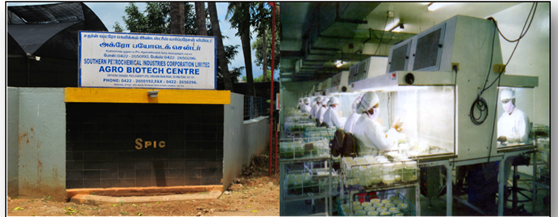Bio Technology :: Banana Tissue Culture
SPIC AGRIBIOTECH CENTRE
|
SPIC's agri biotech offers products for sustainable eco-friendly agricultural development with a global footprint. SPIC produces high-yielding, micro propagated bananas, gerberas, produced from its advanced tissue culture plant and have a global market. The market leader in tissue culture bananas, SPIC produces all major varieties G-9, Red Banana and Nendran. SPIC is the exclusive representative of Schreurs, Netherlands, world leaders in gerbera (http://www.schreurs.nl). The tissue culture facility is located in Coimbatore with an area of 24 acres with production of 10 million plants per year. The company has green house area of 700 sq m and shaded area of 32, 000 sq m with technology of 10000 sterile environment. The center has developed protocols for the multiplication of more than 200 varieties of 32 crops. All products are screened for viruses and microbes with procedures like ELISA and PCR. The centre has been assessed and certified by the Accreditation Unit of Department of Biotechnology, New Delhi.
|
|
In today’s scenario of horticulture crops, banana is one of the major crop producing higher economic returns. In India, TamilNadu alone cultivates 2 lakh acres but the production is very low of 20-25 Kg/bunch. Tissue culture banana had overcome this, producing 35-45 kg/bunch. The tissue culture banana has following advantages
- Disease free quality plants
- Highly vigorous growing
- Uniform maturity
- High yielding
- Plantlets are available throughout the year
Tissue culture banana-Cultivation practices
Sowing Season and Varieties
Fertilizer application
Fertigation and growth regulators
Irrigation and Post technology
Crop Protection
Harvesting and Yield |
Sowing Season and Varieties:
Banana cultivation is practiced based on regional conditions but tissue culture bananas can be cultivated throughout the year. G-9, Red banana and Nendhran are produced through tissue culture techniques and marketed.
Sowing Technique: |
| Variety |
Spacing |
Plantlets required per acre |
| G-9 |
6 feet X 6 feet |
1234 |
| Red banana |
7 feet X 7 feet |
907 |
| Nendhran |
6 feet X 6 feet |
1234 |
|
With above spacing, dig soil pit with 1½x1½x1½ feet; apply Farm Yard Manure with same level of pit. With digged soil mix 300g gypsum, 20g carbofuran 3G, 250g Neem Seed Kernel and irrigate it. The major difference between banana and tissue culture banana differs in number of roots. The tissue culture banana produces twice the amount of roots compared to normal banana at any season. So it is better to prevent roots from getting damage.
- It is always better to plant tissue culture plants in wet soil at evening.
- Apply Emison 1g/litre or Paglal 1g/litre or bleaching powder 10g/litre of water to root zone after 1 week of planting. Take care that the entire root gets soaked well with the solution. Repeat the same on 3rd and 5th months after planting.
- At summer times, sow sunhemp at 1 feet space as intercrop. This prevents the soil heat, rhizome rot and nematode infestation. Remove the sunhemp after 45 days of planting and use as green manure.
- Remove the entire plantlet from polythene bag/tray completely and sow in the middle of the pit and irrigate immediately.
- Practicing the above methods will prevent young plantlets from damage.
Fertilizer application:
At 45 days after planting apply FYM 5 kg/tree. For fields tested with soil analysis, recommended fertilizer application will provide better results. Particularly in G9 banana, 27th leaf will be followed by shredding of glassy 28th leaf with emergence of new bunch. The emergence of leaf is based on the location of sowing and usually takes 6-8 months. The number and quality of bunch depends upon the initial growth thus application of fertilizer based on recommendations will give higher yield. Since tissue culture banana produces larger number of roots, the uptake of fertilizers is very efficient.
Inorganic fertilizers:
Recommended fertilizer amount:
For the required amount of 200:60:350 g NPK/tree, apply DAP 100g, Urea 375g and MOP 500g. The amount of fertilizer will differ based on soil conditions.
Fertilizer table (g/tree): |
| Days |
SPIC DAP |
SPIC Urea |
SPIC MOP |
| 45 days |
100 |
25 |
25 |
| 90 days |
0 |
50 |
25 |
| 125 days |
0 |
100 |
125 |
| 150 days |
0 |
100 |
125 |
| 180 days |
0 |
100 |
100 |
| After flowering |
0 |
0 |
100 |
| Total per tree |
100 |
375 |
500 |
Dig a pit at 1 feet from tree and apply the fertilizers and irrigate it.
Fertigation and growth regulators:
NPK (g/tree)- 150:45:185
| Days |
Fertilizer |
Kg/hectare |
Kg/days/acre |
| 1-90 days |
19:19:19
13:0:46
urea |
192
93
70 |
2.130
1.033
0.777 |
| 91-150 days |
0:52:34
13:0:46
Urea |
59
82.5
117.5 |
0.983
1.376
1.958 |
| 151-300 days |
13:0:46
urea |
282.5
150 |
1.884
1.000 |
Apply Azospirrilum (SPIC Biogold) and Phosphobacteria at 6 kgs/acre on 3rd and 5th month after planting. Mix Azospirrilum and Phosphobacteria with equal ratio of 25 kg sand and 25 kg of FYM and apply. Do not use it with other fertilizers. Spray 0.2% Microfoot at 4th and 10th month after planting.
Growth Regulators:
At 90th, 150th and 210th days after fertilizer application, spray SPIC Psitosym 250 ml per litre of water. |
Irrigation and Post technology:
Based on soil type and moisture, irrigation should be carried out to prevent banana from drying. Most care should be taken on irrigating from flowering to maturity stage.
- After 3rd month, desukcring should be carried out in order to prevent damage.
- Dry leaves and waste materials around the tree should be removed.
- Based on the need, give support to banana tree using bamboo or oak sticks.
- Carry out mulching on 3rd, 4th and 7th month after planting.
Crop Protection:
Aphids:
Symptoms:
- The adult remains under the leaf and sucks the sapcausing yellowing. It is vector of banana streak virus disease.
Control measures:
- Spray SPIC Neem gold at 500ml/acre.
|
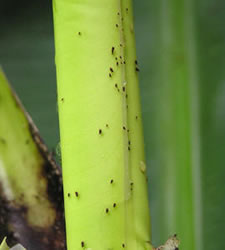 |
 |
Nematode:
Symptoms:
- Nematode causes stunted growth and yield loss. On digging up of soil, the roots will be found with galls.
Control measures:
- At the time of sowing, apply carbofuran 3G 20g to the pit, 30 g at 3rd and 5th month after planting.
Rhizome weevil:
Symptoms:
- On digging up of soil, holes will be visible on rhizome with oozing of gum.
Control measures:
- At the time of sowing, apply carbofuran 3G 20g to the pit, 30 g at 3rd and 5th month after planting.
|
 |
Diseases:
Tikka leaf spot:
Symptoms:
- Eye like spots will appear on the leaf.
Control measures:
- Spray Venish 500ml or carbendezim 250 g/l to control tikka leaf spot.
|
 |
Fusarium wilt:
Symptoms:
- The leaves becomes yellow and falls downward, top shoot alone will appear green in colour.
Control measures:
- Apply 40 mg of carbendezim capsule. At root region, remove the soil and through an injection apply the above and cover with clay. The severly-affected tree should be removed from the field.
|
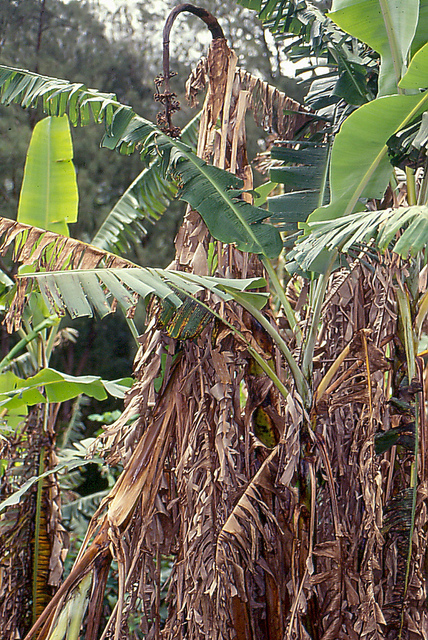 |
Viral diseases
Bunchy top and banana streak virus disease:
Symptoms:
- The leaves size become smaller and cluster together. The tender shoots rots. The leaves would appear with alternate yellow and greenish lesions.
Control measures:
- The vector for the disease is aphid. Plant intercrops such as Violet pumpkin varieties, bhendi and tomato that are preferred by aphids. As precaution, spray SPIC neem gold 500 ml or dimethoate 250 ml per acre.
|
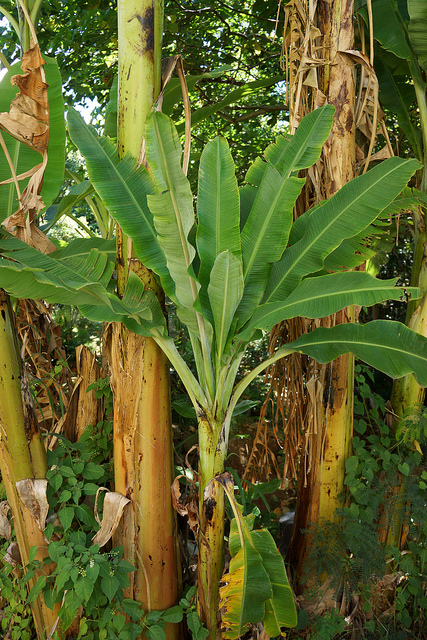 |
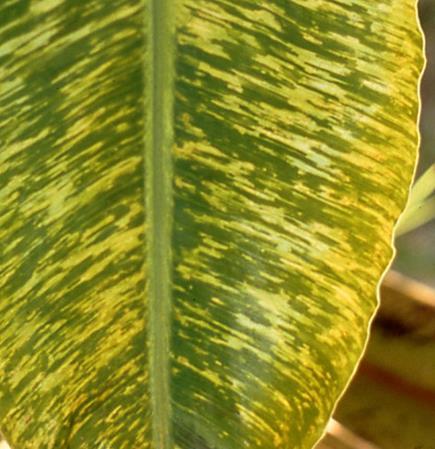 |
Note:
The above diseases are mostly spread at young plantlets stage. SPIC agro biotech carries out ELISA test to select and sell disease free tissue culture plantlets. Hence the virus dieases are prevented using tissue culture plants. Practicing proper crop protection methods as per recommendations at growing stage would prevent from disease infection.
Harvesting and Yield:
After 100 days after flowering stage, harvesting could be carried out.
| G9 |
45-45 tonnes/acre |
| Red banana |
25-30 tonnes/acre |
| Nendhran |
18-20 tonnes/acre |
Note:
The disease free tissue culture plantlets are delivered from SPIC agro biotech. The plantlets are not insect or disease resistant. The yield is based on soil conditions, crop management, climatic condition, natural calamities, weed and crop protection methods. The company is not responsible for yield loss due to above reasons if any.
|
Source
| |
Agri business division
SPIC Ltd,
SPIC House
88 Mount Road Guindy
Chennai 600032,
India
Telephone +91 44 22350245
Fax +91 44 22352163
E-mail: cmab@spic.co.in
www.spic.in |
|
SPIC AGRO BIOTECH CENTRE
Chitirachavadi, pulavapatti post,
Siruvani road,
Cooimbatore- 641 101
Phone: 0422-265 0192
Cellular: 98652 65858/99940 06220/ 98657 34390
E-mail: agribusiness@spic.co.in |
|
|
|
|
Updated on October 10, 2014 |
|

